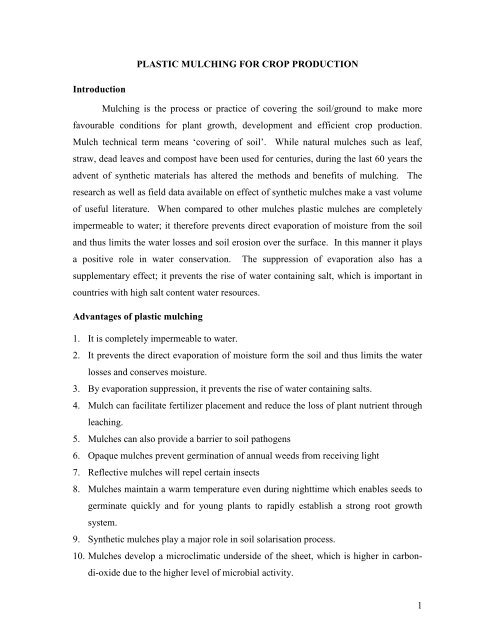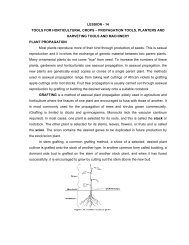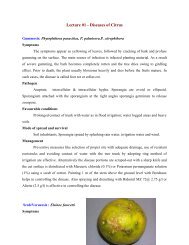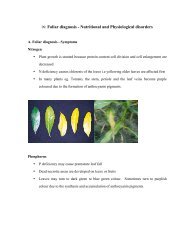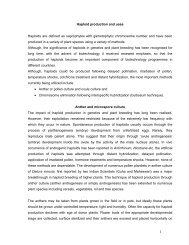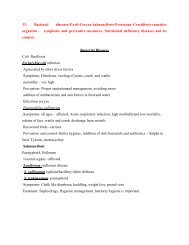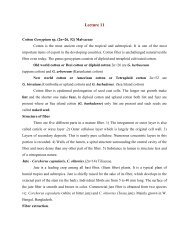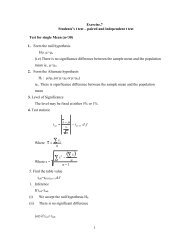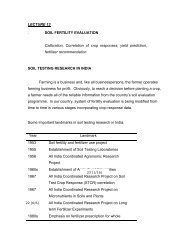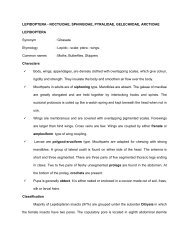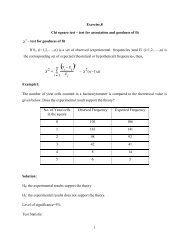Plastic mulching for crop production - TNAU Agritech Portal
Plastic mulching for crop production - TNAU Agritech Portal
Plastic mulching for crop production - TNAU Agritech Portal
You also want an ePaper? Increase the reach of your titles
YUMPU automatically turns print PDFs into web optimized ePapers that Google loves.
PLASTIC MULCHING FOR CROP PRODUCTION<br />
Introduction<br />
Mulching is the process or practice of covering the soil/ground to make more<br />
favourable conditions <strong>for</strong> plant growth, development and efficient <strong>crop</strong> <strong>production</strong>.<br />
Mulch technical term means ‘covering of soil’. While natural mulches such as leaf,<br />
straw, dead leaves and compost have been used <strong>for</strong> centuries, during the last 60 years the<br />
advent of synthetic materials has altered the methods and benefits of <strong>mulching</strong>. The<br />
research as well as field data available on effect of synthetic mulches make a vast volume<br />
of useful literature. When compared to other mulches plastic mulches are completely<br />
impermeable to water; it there<strong>for</strong>e prevents direct evaporation of moisture from the soil<br />
and thus limits the water losses and soil erosion over the surface. In this manner it plays<br />
a positive role in water conservation. The suppression of evaporation also has a<br />
supplementary effect; it prevents the rise of water containing salt, which is important in<br />
countries with high salt content water resources.<br />
Advantages of plastic <strong>mulching</strong><br />
1. It is completely impermeable to water.<br />
2. It prevents the direct evaporation of moisture <strong>for</strong>m the soil and thus limits the water<br />
losses and conserves moisture.<br />
3. By evaporation suppression, it prevents the rise of water containing salts.<br />
4. Mulch can facilitate fertilizer placement and reduce the loss of plant nutrient through<br />
leaching.<br />
5. Mulches can also provide a barrier to soil pathogens<br />
6. Opaque mulches prevent germination of annual weeds from receiving light<br />
7. Reflective mulches will repel certain insects<br />
8. Mulches maintain a warm temperature even during nighttime which enables seeds to<br />
germinate quickly and <strong>for</strong> young plants to rapidly establish a strong root growth<br />
system.<br />
9. Synthetic mulches play a major role in soil solarisation process.<br />
10. Mulches develop a microclimatic underside of the sheet, which is higher in carbondi-oxide<br />
due to the higher level of microbial activity.<br />
1
11. Under mulch, the soil structure is maintained during <strong>crop</strong>ping period<br />
12. Early germination almost 2-3 days.<br />
13. Better nodulation in <strong>crop</strong>s like Groundnut.<br />
14. Less nematodes population.<br />
15. Water erosion is completely averted since soil is completely covered <strong>for</strong>m bearing<br />
action of rain drops.<br />
16. When compared to organic mulches, it serves <strong>for</strong> a longer period.<br />
Moisture conservation<br />
• <strong>Plastic</strong> film with its moisture barrier properties does not allow the soil moisture to<br />
escape Water that evaporates from the soil surface under mulch film, condenses<br />
on the lower surface of the film and falls back as droplets.<br />
• Thus moisture is preserved <strong>for</strong> several days and increases the period between two<br />
irrigations.<br />
• The irrigation water or rainfall either moves into the soil thru holes on the mulch<br />
around the plant area or through the un-mulched area.<br />
Weed control<br />
• Black plastic film does not allow the sunlight to pass through on to the soil<br />
• Photosynthesis does not take place in the absence of sunlight below black film<br />
hence, it arrests weed growth<br />
2
Limitations<br />
• They are costly to use in commercial <strong>production</strong> when compared to organic<br />
mulches.<br />
• Probability of ‘burning’ or ‘scorching’ of the young pants due to high<br />
temperature of black film.<br />
• Difficulty in application of top dressed fertilizer<br />
• Reptile movement and rodent activities are experienced in some places.<br />
• More runoff<br />
• Environmental pollution<br />
• Difficult in machinery movement<br />
• Can not be used <strong>for</strong> more than one season using thin mulches<br />
• Weed penetration with thin films<br />
• Toxic to livestock<br />
Areas of application<br />
Mulching is mainly employed <strong>for</strong><br />
a. Moisture conservation in rainfed areas<br />
b. Reduction of irrigation frequency and water saving in irrigated areas<br />
c. Soil temperature moderation in greenhouse cultivation<br />
d. Soil solorisation <strong>for</strong> control of soil borne diseases<br />
e. Reduce the rain impact, prevent soil erosion and maintain soil structure<br />
f. In places where high value <strong>crop</strong>s only to be cultivated<br />
Types of mulch film<br />
A wide range of plastic films based on different types of polymers have all been<br />
evaluated <strong>for</strong> <strong>mulching</strong> at various periods in the 1960s. LDPE, HDPE and flexible PVC<br />
have all been used and although there were some technical per<strong>for</strong>mance differences<br />
between them, they were of minor nature. Owing to its greater permeability to long wave<br />
radiation which can increase the temperature around plants during the night times,<br />
polyethylene is preferred. Today the vast majority of plastic mulch is based on LLDPE<br />
because it is more economic in use.<br />
3
Basic properties of mulch film<br />
a. Air proof so as not to permit any moisture vapour to escape.<br />
b. Thermal proof <strong>for</strong> preservation of temperature and prevention of evaporation<br />
c. Durable at least <strong>for</strong> one <strong>crop</strong> season<br />
Importance of parameters of the plastic film<br />
a) Thickness<br />
Normally the thickness of the film does not affect the <strong>mulching</strong> effect except<br />
when it is used <strong>for</strong> solorisation. But some of the recent references do indicate the impact<br />
of film thickness on <strong>crop</strong> yield. Since it is sold by weight it is advantageous to use as thin<br />
a film as possible but at the same time due consideration should be given <strong>for</strong> the<br />
longevity of the film. The early mulch film used were of 60-75 micron (240-300 gauge)<br />
thickness, and today it is possible to have 15 micron thick film due to advent of film<br />
extrusion technology. These films are mechanically weak, as shown by their easy tearing<br />
when pulled tension.<br />
b) Width<br />
This depends upon the inter row spacing. Normally a one to one and half meter<br />
width film can be easily adopted to different conditions.<br />
c) Per<strong>for</strong>ations<br />
The per<strong>for</strong>ations may be advantageous under some situations and<br />
disadvantageous <strong>for</strong> some other situation. The capillary movement of water and fertilizer<br />
distribution will be better and more uni<strong>for</strong>m under unper<strong>for</strong>ated condition. But <strong>for</strong><br />
prevention of water stagnation around the plants, per<strong>for</strong>ation is better. But it has got the<br />
disadvantages of encouraging weed growth.<br />
d) Mulch colour<br />
The colour of the mulch affects<br />
i. Soil temperature<br />
ii. Temperature of air around the plants<br />
iii. Soil salinity<br />
a. Due to lesser quantity of water used<br />
b. Due to reduction in evaporation and prevention of upward movement of water.<br />
4
Transparant film - Deposits more salt on soil surface<br />
Black film - Restricts water movement and upward movement of<br />
salt is reduced.<br />
iv. Weed flora - Black film<br />
v. Insect control - Opaque while film acts as golden colour and attracts<br />
insects<br />
5
Selection of mulch<br />
The selection of mulches depends upon the ecological situations and primary and<br />
secondary aspects of <strong>mulching</strong><br />
Rainy season - Per<strong>for</strong>ated mulch<br />
Orchard and plantation - Thicker mulch<br />
Soil solarisation - Thin transparent film<br />
Weed control through solarisation - Transparent film<br />
Weed control in <strong>crop</strong>ped land - Black film<br />
Sandy soil - Black film<br />
Saline water use - Black film<br />
Summer <strong>crop</strong>ped land - White film<br />
Insect repellent - Silver colour film<br />
Early germination - Thinner film<br />
Methods of <strong>mulching</strong><br />
• Orchard/Fruit/Established trees<br />
• Mulching area should preferably be equivalent to the canopy of the plant.<br />
• Required size of mulch film is cut from the main roll.<br />
• Clean the required area by removing the stones, pebbles, weeds etc.<br />
• Till the soil well and apply a little quantity of water be<strong>for</strong>e <strong>mulching</strong><br />
• Small trench could be made around the periphery of the <strong>mulching</strong> area to<br />
facilitate anchoring of the mulch film.<br />
• Cover the film to the entire area around the tree and the end should be buried in<br />
the ground.<br />
• Semi circular holes could be made at four corners of the film in order to facilitate<br />
water movement.<br />
• The position of the slit/opening should be parallel to the wind direction<br />
6
• Cover the corners of the film with 4-6 inches of soil on all sides to keep the film<br />
in position.<br />
• In hard soil, make a trench of 1’x1’x2’ depth on four corners of the <strong>mulching</strong> area<br />
and fill it up with gravel or stones, cover the trenches with the mulch film and<br />
allow the water to pass through the mulch to the trenches via semi circular holes<br />
on the film<br />
Mulch Laying Techniques<br />
i. Mulch should be laid on a non-windy condition<br />
ii. The mulch material should be held tight without any crease and laid on the bed<br />
iii. The borders (10 cm) should be anchored inside the soil in about 7-10 cm deep in<br />
small furrows at an angle of 45°.<br />
Pre planting mulch:<br />
The mulch material should be punctured at the required distances as per <strong>crop</strong><br />
spacing and laid on the bed. The seeds/seedlings should be sown/transplanted in the<br />
holes.<br />
Mulching techniques <strong>for</strong> Vegetables /close space <strong>crop</strong><br />
• Very thin film is used <strong>for</strong> short duration <strong>crop</strong>s like vegetables.<br />
• Required length of film <strong>for</strong> one row of <strong>crop</strong> is taken and folded in ‘thaan’ <strong>for</strong>m at<br />
every one metre along the length of the film.<br />
• Round holes are made at the center of the film using a punch or a bigger diameter<br />
pipe and a hammer or a heated pipe end could be used.<br />
• One end of the mulch film (along width) is anchored in the soil and the film is<br />
unrolled along the length of the row of planting.<br />
• Till the soil well and apply the required quantity of FYM and fertilizer be<strong>for</strong>e<br />
<strong>mulching</strong>.<br />
• Mulch film is then inserted (4-6”) into the soil on all sides to keep it intact<br />
• Seeds are sown directly through the holes made on the mulch film.<br />
• In case of transplanted <strong>crop</strong>s, the seedlings could be planted directly into the hole.<br />
• For <strong>mulching</strong> established seedlings, the process of punching the hole is the same.<br />
One end of the film along the width is burried in the soil and the mulch film is<br />
then unrolled over the saplings. During the process of unrolling, the saplings are<br />
7
held in the hand and inserted into the holes on the mulch film from the bottom<br />
side, so that it could spread on the topside.<br />
Precautions <strong>for</strong> Mulch Laying<br />
• Do not stretch the film very tightly. It should be loose enough to<br />
overcome the expansion and shrinkage conditions caused by temperature<br />
and the impacts of cultural operation.<br />
• The slackness <strong>for</strong> black film should be more as the expansion, shrinkage<br />
phenomenon is maximum in this color.<br />
• The film should not be laid on the hottest time of the day, when the film<br />
will be in expanded condition.<br />
Removal of mulch<br />
In case the mulch film needs to be used <strong>for</strong> more than one season (thicker film)<br />
the plant is cut at its base near the film and the film is removed and used.<br />
By compounding appropriate additives into the plastics it is possible to produce a<br />
film, which, after exposure to light (solar radiation) will start to breakup at a pre<br />
determined time and eventually disintegrated into very small friable fragments. The time<br />
period can be 60, 90, 120 or 150 days and <strong>for</strong> maize a 60-day photodegradable mulch is<br />
used. However there are still some further problems to resolve. It has been observed that<br />
the edges of the mulch, which are buried to secure the mulch to the soil, remain intact and<br />
become a litter problem when brought to the surface during the post-harvest ploughing.<br />
Currently much development ef<strong>for</strong>t is being made to find a satisfactory solution to this<br />
problem.<br />
In direct contrast in developing countries which have agricultural labour available<br />
a different approach can be made. Fro example in the people Republic of China trials<br />
have been made using a plastic mulch of 15 micron thickness on a sugarcane <strong>crop</strong>. After<br />
the cuttings have been planted through the mulch they are left to grow <strong>for</strong> a period of one<br />
month. Then the mulch is removed by hand and wound up so that it can be utilized <strong>for</strong> a<br />
second season. A yield increase of 26% was obtained.<br />
These two examples not only demonstrated the diversity of mechanisms available<br />
<strong>for</strong> resolving the problems of mulch removed, but also illustrate the different technique,<br />
which have been developed in different countries. It also indicates the necessity <strong>for</strong> each<br />
country to adapt and develop <strong>mulching</strong> technique to meet its own specific requirements<br />
8
of climate, resources and economics. To undertake such technology development there is<br />
a specific requirement that both plastics and agricultural development facilities are<br />
available.<br />
Irrigation practices under <strong>mulching</strong><br />
• In drip irrigation the lateral pipelines are laid under the mulch film<br />
• In case inter-cultivation need to be carried out, it is better to keep the laterals and<br />
drippers on top of the mulch film and regulate the flow of water through a small<br />
pipe or through the holes made on the mulch film<br />
• In flooding the irrigation water passes through the semi circular holes on the<br />
mulch sheet.<br />
Cost economics of <strong>mulching</strong><br />
The cost economic of <strong>mulching</strong> is an important aspect. In a leveled field if<br />
<strong>mulching</strong> is to be done, then the film area required will be almost equal to that of field<br />
itself. In fields with ridges and furrows <strong>mulching</strong> material required will be sizably more<br />
than the field area. However <strong>mulching</strong> is carried out in strips covering 50-60% of field<br />
area. In the present era of minimizing rainfall conserving moisture with <strong>mulching</strong><br />
transgresses the plan of economic analysis in the sense that the real cost analysis would<br />
be even meaningless in the case of a precious commodity like water. A typical<br />
calculation has been given <strong>for</strong> working out cost economics of <strong>mulching</strong> in Bhendi <strong>crop</strong>.<br />
9
Assumptions made in cost estimation<br />
• Power and source of water are available.<br />
• Price of synthetic film of black LLDPE is taken as Rs. 120 per Kg.<br />
• PVC film is assumed to last <strong>for</strong> 2 seasons only. However in practice, black PVC<br />
film may well last longer than two seasons, if handled properly, in that case<br />
savings could be correspondingly larger.<br />
Cost Economics of <strong>mulching</strong><br />
Sl. No.<br />
Particulars<br />
Black LLDPE<br />
film<br />
Control<br />
1 Cost of cultivation (Rs. / ha) 16000 21000<br />
2 Cost of mulch film per season 16600 --<br />
3 Total seasonal cost (2+1) 32600 21000<br />
4 Yield of produce (kg/ha) 11660 7770<br />
5 Market price (Rs./kg) 6.00 6.00<br />
6 Revenue (Rs./ha) 69960 46620<br />
7 Total expenditure 32600 *21000<br />
8 Net income 37360 25620<br />
9 Difference in net seasonal income 11740 25620<br />
10 Benefit cost ratio 1.45: 1<br />
* 60% area covered with film, 50 micron film of 1 kg cover 22 sq. m<br />
Case studies<br />
Effect of <strong>mulching</strong> on groundnut<br />
An experiment on <strong>mulching</strong> with plastic films was conducted <strong>for</strong> groundnut<br />
Aliyarnagar Research Station. The film was LLDPE black and the thickness were 15<br />
micron (T10, 20 micron (T2), 25 micron (T3), coir pith at the rate of 20 t/ha (T4) and<br />
fifth plot was control (T5). Each plot was 2m x 1m and experiments were replicated four<br />
times. For sampling purpose, 5 plants in each of the experimental plots were considered<br />
<strong>for</strong> rot length on 60 th day. The <strong>crop</strong> was harvested on 110 th day since sowing.<br />
Parameters like soil moisture, soil temperature, germination; weed, root and yield were<br />
observed.<br />
10
<strong>Plastic</strong> <strong>mulching</strong> in groundnut<br />
Treatment<br />
Available<br />
moisture at<br />
harvest (%)<br />
Wet weed<br />
wt. (g)/plot<br />
at 45 th day<br />
No. of<br />
pods/plant<br />
Pod yield<br />
(kg/ha)<br />
T 1 – 15 micron LLDPE (black) 7.69 150 9.00 1337<br />
T 2 – 20 micron LLDPE (black) 7.62 156 7.75 1118<br />
T 3 – 25 7.05 179 7.50 1275<br />
T 4 – Coir pith 20 t/ha 6.50 257 6.75 1012<br />
T 5 Control – no mulch 5.90 370 6.75 850<br />
Mulching with 15 micron LLDPE film was found to give higher pod yield due to<br />
better moisture conservation, reduced weed growth, when compared to coirpith mulch<br />
and control. From the results it was also seen that the thickness of film did not matter<br />
much in conserving moisture.<br />
Effect of <strong>mulching</strong> on cotton <strong>crop</strong><br />
Experiments were conducted at <strong>TNAU</strong>, by PDC, CAE <strong>for</strong> dry land cotton,<br />
covering 50% of land area by 25 micron LLDPE black polyethylene film. The replicated<br />
trial was repeated <strong>for</strong> 3 seasons from 1992-93 <strong>for</strong> LRA 5166 cotton variety. For<br />
comparative study purpose coir pith at a rate of 12.5 t/ha and organic mulch of 12.5 t/ha<br />
were also taken. Plot size was 5 m x 4 m.<br />
11
Effect of mean yield of cotton over 3 years<br />
Treatments<br />
Mean kapas yield (kg/ha)<br />
Wet weed wt./plot (gm) at<br />
45th day<br />
Black LLDPE (20 micron) 673 303<br />
Coir pith 565 575<br />
Organic mulch 509 510<br />
No mulch 436 1121<br />
Effect of mulch on root length and plant height in castor and redgram<br />
To study the effect of <strong>mulching</strong> on plant height and root length under dryland<br />
conditions plants like redgram and castor <strong>crop</strong> were selected and trials were conducted at<br />
<strong>TNAU</strong> campus. The results are as shown below:<br />
Effect of mulch on plant height and root length<br />
Treatment<br />
Plant<br />
height<br />
(cm)<br />
Red gram (SAI) Castor (CO 1)<br />
Root<br />
length<br />
(cm)<br />
Root<br />
No.<br />
Plant<br />
height<br />
(cm)<br />
Root<br />
length<br />
(cm)<br />
30 mic. LLDPE black 45.0 25.3 5 50.1 38.3 8<br />
40 mic. LLDPE black 41.6 20.7 3 48.7 35.8 5<br />
50 mic. LLDPE black 41.9 23.0 3 48.0 34.3 5<br />
No mulch 22.1 20.9 4 30.1 28.6 6<br />
Root<br />
No.<br />
Effect of <strong>mulching</strong> on vegetable <strong>crop</strong>s<br />
From the year 1986 onwards, Coimbatore PDC is continuously conducting<br />
experiments on <strong>mulching</strong> <strong>for</strong> principal vegetable <strong>crop</strong>s like Bhendi, Tomato and Chilli.<br />
Replicated trials were conducted with three irrigation levels and two type of mulches as<br />
follows.<br />
I 1 – Irrigation at 0.41 IW/CPE<br />
I 2 – Irrigation at 0.61 IW/CPE<br />
I 3 – Irrigation at 0.61 IW/CPE<br />
The plot size was 5.5 m x 2.5 m/each<br />
M o – Control – no mulch<br />
M 1 – Control – no mulch<br />
M 2 – Control – no mulch<br />
12
Each experiment was repeated thrice in different season <strong>for</strong> the same variety of<br />
<strong>crop</strong> <strong>for</strong> confirming the results. The mean values of yields of each <strong>crop</strong> are tabulated<br />
below.<br />
1. Bhendi<br />
Effect of <strong>mulching</strong> on Bhendi yield (4 year average) in kg/ha<br />
Treatment M 0 M 1 M 2 Mean<br />
I 1 6593 8249 11292 8698<br />
I 2 8145 9156 12173 9825<br />
I 3 8571 8686 11555 9604<br />
Mean 77770 8697 11660<br />
2. Tomato<br />
Effect of <strong>mulching</strong> on tomato yield<br />
Mean yield data over three years<br />
Treatment M 0 M 1 M 2 Mean<br />
I 1 8322 10260 11767 10116<br />
I 2 9527 11415 13012 11318<br />
I 3 11916 12326 13427 12556<br />
Mean 9922 11334 12735<br />
(14.2)* (28.4)*<br />
*Percentage of yield increase over unmulched control / plot<br />
3. Chilli<br />
Effect of <strong>mulching</strong> on Chilli yield<br />
Mean yield data over three years<br />
Treatment M 0 M 1 M 2 Mean<br />
I 1 3972 4353 4916 4414<br />
I 2 4732 5115 5475 5107<br />
I 3 4940 5359 5872 5390<br />
Mean 4548 4942 5421<br />
13
Effect of <strong>mulching</strong> on maize <strong>crop</strong><br />
Experiments conducted in <strong>TNAU</strong> main campus showed that evaporation loss<br />
from the maize <strong>crop</strong> field can be arrested by covering the soil either with plastic film of<br />
20 micron (80 gauge) of black sheet or with organic farm waste like cumbu straw. Due<br />
to this water economizing to the level of 12-20% was achieved. Hence it is a viable<br />
technology under moisture stress condition.<br />
Effect of <strong>mulching</strong> on maize yield and WUE<br />
Treatment<br />
Seasonal total<br />
water (mm)<br />
Yield in kg/ha<br />
WUE (kg/ha<br />
mm)<br />
1. Control 463 5562 11.90<br />
2. <strong>Plastic</strong> mulch with 20 micron 373 5650 15.10<br />
3. Cumbu straw 401 5594 13.90<br />
4. Coir pith 403 5466 13.86<br />
Conclusions on basis of experiments conducted so <strong>for</strong><br />
1. Flexible PVC film is suitable <strong>for</strong> <strong>mulching</strong>. PVC film shows the expected over all<br />
advantages of mulch irrigation such as conservation of moisture and control of weed<br />
growth.<br />
2. Savings in water appear to be the main advantage and such savings are found to vary<br />
from 20% to as high as 75%. The savings in water are more pronounced in arid<br />
areas. These experiments clearly established that such savings could be of critical<br />
importance in arid areas. Areas having elaborate irrigation do not appear to show<br />
considerable advantage. Mulching, there<strong>for</strong>e, would appear and promising <strong>for</strong> arid<br />
lands.<br />
3. Yields of <strong>crop</strong>s may not necessarily be substantially increased directly by usage of<br />
<strong>mulching</strong>, but more land can be cultivated with the available amount of water and<br />
thus overall cultivation of <strong>crop</strong>s can be increased. However, it is significant to not<br />
that in both experiments conducted in arid areas increased yields were reported.<br />
14
4. 150-200 gauge PVC film based on normal compositions would withstand weathering<br />
<strong>for</strong> 2 seasons. However, the life of film could be increased by covering the film with<br />
the soil and thus preventing direct exposure of the film to sunlight. PVC film based<br />
on special compositions would certainly have better weather resistance and would<br />
last <strong>for</strong> several seasons. Black as well as completely opaque, white film would be<br />
better than natural semi-transparent film in respect of weather resistance. Black film<br />
would appear to be better <strong>for</strong> colder climates while opaque white film would show<br />
some advantages <strong>for</strong> warm climates.<br />
5. Black PVC film shows better control on weed growth than completely opaque white<br />
and natural translucent film.<br />
Conclusion<br />
<strong>Plastic</strong>ulture is crucial to Indian agriculture in view of the changing technological<br />
scenario <strong>for</strong> boosting <strong>crop</strong> yields and productivity. Introduction of linear low density<br />
polyethylene (LLDPE) as a mulch film has brought a revolution in agricultural water<br />
management. It is actually a boon to dryland farmers. This is one of the fastest growing<br />
plasticultural applications in the world. The cost of LLDPE film is also lesser than one<br />
third of LDPE mulch film. Moreover <strong>for</strong> mulch activity lower thickness (15 to 20<br />
microns) are highly suitable. However due to ever increasing cost of raw materials the<br />
films are costlier now. Hence Government should take all possible measures to produce<br />
the film in a mass scale and make it available to the farmers at a reasonable price.<br />
Subsidy may also be given through banks to encourage the farmer to adoption soil<br />
<strong>mulching</strong>. Low cost machines may be developed <strong>for</strong> spreading and rolling down the film<br />
in the field. PFDC’s may be geared up <strong>for</strong> large scale demonstration in farmer’s field to<br />
give a wide publicity.<br />
15
Studies on <strong>mulching</strong> at various centres of PFDC's all over India<br />
Sl.<br />
No.<br />
Crop Location of PFDC Mulch material<br />
Increase<br />
in yield<br />
(%)<br />
Additional<br />
income<br />
(Rs./ha)<br />
1. Chilli Navasari (Gujarat) Black plastic (50 micron) 60.1 10140.00<br />
2. Brinjal Navasari (Gujarat) Black plastic (50 micron) 27.1 7400.00<br />
3. Sugarcane Navasari (Gujarat) Black plastic (50 micron) 50.2 25000.00<br />
4. Chilli Navasari (Gujarat) Green plastic (50 micron) 59.0 22190.00<br />
5. Cauliflower Hisar Black plastic (50 micron) 31.9 6751.00<br />
6. Potato Pantnagar (UP) Black plastic (50 micron) 35.5 8700.00<br />
7. Cauliflower Pantnagar (UP) Black plastic (50 micron) 71.0 16120.00<br />
8. Tomato Pantnagar (UP) <strong>Plastic</strong> film (25 micron) 46.5 11250.00<br />
9. Okra Pantnagar (UP) <strong>Plastic</strong> film (25 micron) 47.85 9250.00<br />
10. Tomato Pantnagar (UP) <strong>Plastic</strong> film (25 micron) 79.2 22764.00<br />
11. Tomato Kharagpur (WB) <strong>Plastic</strong> film (25 micron) 65.4 43210.00<br />
12. Okra Kharagpur (WB) <strong>Plastic</strong> film (25 micron) 55.1 19625.00<br />
13. Guava Delhi <strong>Plastic</strong> film (100 micron) 26.0 --<br />
14. Lemon Delhi <strong>Plastic</strong> film (100 micron) 21.6 --<br />
15. Kinnow Delhi <strong>Plastic</strong> film (100 micron) 46.8 --<br />
16. Pomogranate Delhi <strong>Plastic</strong> film (100 micron) 33.3<br />
17. Brinjal Coimbatore <strong>Plastic</strong> film (25 micron) 33.3 12062.00<br />
18. Bhendi Coimbatore <strong>Plastic</strong> film (25 micron) 46.7 9770.00<br />
19. Bhendi Coimbatore <strong>Plastic</strong> film (25 micron) 54.0 6400.00<br />
20. Chilli Coimbatore <strong>Plastic</strong> film (25 micron) 18.6 6800.00<br />
21. Groundnut Coimbatore <strong>Plastic</strong> film (15 micron) 20.5 7300.00<br />
22. Banana Travacore (Kerala) <strong>Plastic</strong> film (50 micron) 12.6 13906.00<br />
23. Arecanut Travacore (Kerala) <strong>Plastic</strong> film (50 micron) 28.4 --<br />
24. Bhendi Travacore (Kerala) <strong>Plastic</strong> film (50 micron) 25.0 18885.00<br />
25. Maize Rajendranagar (AP) <strong>Plastic</strong> film (25 micron)<br />
44.6 9800.00<br />
26. Brinjal Rajendranagar (AP) <strong>Plastic</strong> film (25 micron)<br />
10.0 15100.00<br />
27. Bhendi Rajendranagar (AP) <strong>Plastic</strong> film (25 micron) 67.0 18300.00<br />
28. Tomato Rajendranagar (AP) <strong>Plastic</strong> film (25 micron) 65.3 13800.00<br />
29. Plum Solan (HP) <strong>Plastic</strong> film (50 micron) 9.2 12000.00<br />
30. Tomato Solan (HP) <strong>Plastic</strong> film (50 micron) 85.6 18250.00<br />
31. Pea Solan (HP) <strong>Plastic</strong> film (50 micron) 66.6 25960.00<br />
32. Apricot Solan (HP) <strong>Plastic</strong> film (50 micron) 33.3 18320.00<br />
33. Peach Solan (HP) 31.2 13890.00<br />
16


